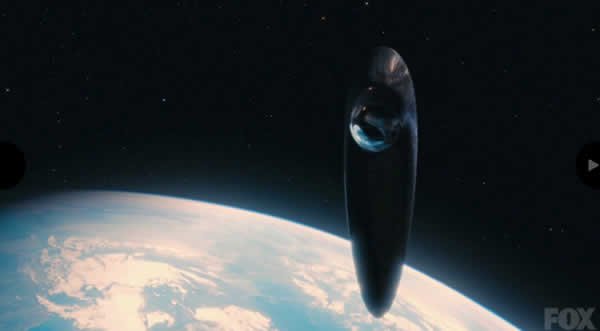
Cosmos Review: “Standing Up in the Milky Way”
Episode One of Cosmos: A SpaceTime Odyssey
Cosmos Articles and Discussion Guides
See Cosmos: A SpaceTime Odyssey for reviews of other episodes and discussion guides for further study.
Cosmos: A SpaceTime Odyssey claims its aim is to promote scientific literacy, but it takes a metaphysical statement as its theme. In the first episode, after a brief look at the immensity of space, the gears on Cosmos’s well-named "ship of the imagination” shift into worldview-based beliefs about billions of years of cosmic evolution and molecules-to-man evolution and stay there.
Opening with the late astronomer Carl Sagan’s now famous assertion—“The cosmos is all that is, or ever was, or ever will be”—Cosmos: A SpaceTime Odyssey premiered on Fox Sunday night. This trip through the cosmos has astrophysicist Neil deGrasse Tyson at the helm of the “ship of the imagination.” In it he promises to take us “from the dawn of time to the distant future.”

At the helm of the “ship of the imagination” above the “pale blue dot” of Earth, astrophysicist Neil deGrasse Tyson promises in Cosmos: A SpaceTime Odyssey to take us from the “dawn of time to the distant future.” (Image courtesy of Fox, http://www.cosmosontv.com.)
Rebooting the 1980 Carl Sagan series, Cosmos: A Personal Voyage, the new 13-part series has a similar goal: to encourage science literacy. Executive producer Seth MacFarlane says, “I think that there is a hunger for science and knowing about science and understanding of science that hasn’t really been fed in the past two decades. We’ve had a resurgence of creationism and intelligent design quote-unquote theory. There’s been a real vacuum when it comes to science education. The nice thing about this show is that I think that it does what the original ‘Cosmos’ did and presents it in such a flashy, entertaining way that, as Carl Sagan put it in 1980, even people who have no interest in science will watch just because it’s a spectacle.”1 MacFarlane blames scientific illiteracy on the “rise of schools questioning evolution” and hopes the series will put an end to the sort of thinking that would question evolution so that scientific literacy can march forward.1
Ironically, despite the claim that this series is designed to advance science literacy, by adopting Sagan’s theme—“The cosmos is all that is, or ever was, or ever will be”—the producers have hoisted a most unscientific flag above this “ship of the imagination.” Answers in Genesis astronomer Dr. Danny Faulkner comments as follows:
There is not a bit of science in that statement. When Sagan said it 34 years ago and then wrote it in his book, a lot of people were saying, “Wow! What a profound scientific statement,” but it’s actually a philosophical statement. It is denial of the supernatural, saying the only thing that exists is the physical world, the natural world. But to say that with any certainty Sagan had to get outside the physical universe and see that the physical universe is all that there is. And he would have had to do that in eternity past and in eternity future in order to say that. If he could really see that, then he would be god. It’s a very bold, metaphysical statement. It’s an assertion. But it’s not science. It’s not a scientific statement.
Test Ideas by Experiment and Observation
Tyson says in the program that the new Cosmos series will not only examine the origin and history of the universe from the dawn of time but also examine “the saga of how wandering bands of hunters and gatherers found their way to the stars.” Listing the steps in the scientific method, he says,
This adventure is made possible by generations of searchers strictly adhering to a simple set of rules:
- Test ideas by experiment and observation.
- Build on those ideas that pass the test.
- Reject the ones that fail.
- Follow the evidence wherever it leads, and question everything. (Emphasis ours)
Lessons from History
In this introductory episode, Tyson presents the 13.8-billion-year version of the universe’s history through the twin vehicles of colorful computer graphics and charismatic storytelling. Tyson starts out with an educational segment showing the immensity of the known universe. We see Earth’s place in the vastness of space. This section locates the Earth in the solar system, the Milky Way, the Local Group of galaxies, and the Virgo Supercluster.
The program then compares the immensity of space, only observable in the few centuries since the invention of the telescope, to the “staggering immensity of time” since the universe began. Addressing the objection that the Bible does not support a history for the universe spanning billions of years, Tyson spends eleven minutes sandwiched between three commercial breaks telling the story of Giordano Bruno. Bruno was a monk executed by the Inquisition a decade before Galileo invented the telescope. Bruno, believing an infinitely powerful God must have created a vast expanse of space full of other planets, preached that the medieval church’s view of God was too small.
“If Bruno was right, then the sacred books and the authority of the church would be open to question,” Tyson explains. Then he moves from a view of the immensity of space to support for a billions-year scope of the universe’s history by closing the poignant story saying, “Bruno glimpsed the vastness of space but he had no inkling of the staggering immensity of time. How can we humans who rarely live more than a century hope to grasp the vast expanse of time that is the history of the cosmos.” Adding, “The universe is 13.8 thousand million years old,” he then superimposes that 13.8 billion years on a conventional calendar to produce a “cosmic calendar” with the events evolutionary scientists think happened presented in a scale familiar to our minds.

Standing on a cosmic calendar on which the 13.8-billion-year version of “history” is compressed, Neil deGrasse Tyson tells the story from the big bang to the launch of space probe Voyager 1, which bears a message from the people of Earth, including a recording of Carl Sagan’s heart beating. Image courtesy of Fox, http://www.cosmosontv.com.)
Observations on the Cosmic Calendar
Giving a whirlwind tour of the universe’s history, Tyson covers everything from the big bang and the origin of life to the evolution of man and space exploration.
Maintaining that “observational science” supports the big bang theory of origins, Tyson says, “It’s as far back as we can see in time, for now. Our entire universe emerged from a point smaller than a single atom. Space itself exploded in a cosmic fire, launching the expansion of the universe and giving birth to all the energy and all the matter we know today. I know that sounds crazy, but there is strong observational evidence to support the big bang theory. And it includes the amount of helium in the cosmos and the glow of radio waves left over from the explosion” (emphasis ours).
The “observational evidence” to which Tyson refers is not, however, observations that confirm big bang cosmology but interpretations of scientific data that interpret observations within a big bang model of origins. The big bang model is unable to explain many scientific observations, but this is of course not mentioned. (Read more about these in other articles on this website, such as “Big Bang—The Evolution of a Theory,” “Problems with the Big Bang,” and “The Big-Bang God or the God of Scripture?”) Astronomer Dr. Danny Faulkner points out that this is not “observational evidence” about our origins but rather “an interpretation of the data, data that could be interpreted a number of different ways apart from the big bang.”
The program also speaks of the Oort cloud—supposed birthplace of comets to explain how comets could still exist if billion-year-cosmologies were true—but explains the fact that it has never been observed by simply noting it’s too enormous and its components too far apart. The repeated death and recycling of stars is presented as the origin for all elements, and Tyson recalls another famous Sagan-ism, “We are made of star stuff” (“From Dust to Dust”).
Another Great Mystery
Finally, Tyson, standing in a lovely setting surrounded by rocks and pools, deals with the origin of life. Abiogenesis—the origin of life from non-living elements through natural processes—is essential to naturalistic evolutionary dogma. Yet abiogenesis has never been observed in science. Moreover, abiogenesis violates the natural laws that govern everything known to chemical and biological science. Invoking blind faith in evolutionary principles, Tyson therefore says, “We still don’t know how life got started. For all we know it may have come from another part of the Milky Way. The origin of life is one of the greatest unsolved mysteries of science.” Scooping up some water, he adds, “That’s life cooking, evolving all the biochemical recipes for its incredibly complex activities. By Nov 9th [of the cosmic calendar], life was breathing, moving, eating, responding to its environment. We owe a lot to those pioneering microbes.”

Standing by a pool like that in which life presumably evolved, Tyson says that the origin of life is one of science’s greatest unsolved mysteries. Evolutionary scientists do not acknowledge the explanation provided by the Creator in the Bible, an eyewitness account of how and when the laws of nature, the entire universe, and all kinds of life came into being. (Image courtesy of Fox, http://www.cosmosontv.com.)
During our tour of the rest of evolutionary history, we meet Tiktaalik, “one of the first animals to venture onto land” bobbing its cute green face out of the water’s edge. We hear how the rise of mammals and eventually humans was only made possible by the chance occurrence of an asteroid bumped off course crashing into Earth to destroy dinosaurs and let evolving mammals come into their own. Naturally we also see some footprints and hear that once animals learned to walk upright on two legs they evolved into humans, learned to make tools, paint on cave walls, study the stars, and finally send out spacecraft to explore them.
Question Everything . . . Except Evolution
Evolutionary blind faith in a “great mystery” trumps the scientific method.
In short, the opening of Cosmos: A SpaceTime Odyssey spends an hour (less with commercials) summarizing the naturalistic evolutionary view of the origin of life and all things, tricks out the story with colorful computer-generated graphics and photography, and dismisses any religious-based objections by echoing Bruno’s 16th century challenge that our view of God must simply be too small, thus inviting the theistic evolutionary view to become comfortable in the notion that God used a toolkit of star stuff to create us. (Read more about the problems with compromising the plain teachings of God’s Word with the fallible and unverifiable claims of evolution and billions of years in “10 Dangers of Theistic Evolution,” “Theistic Evolution,” “Jesus, Scripture and Error: An Implication of Theistic Evolution,” and “Theistic Evolution: An Incoherent and Inconsistent Worldview?”)
The scientific method has led to the discoveries and technological leaps that shape our lives and our understanding of the universe. Unfortunately, when it comes to the topic of unobservable origins, mainstream scientists who believe big bang cosmology and molecules-to-man evolution think that the god-free framework they have invented is a factual reality that accurately and reliably describes a past they can never examine. They test their ideas about the past within their own concept of what the past was like, and they believe they are actually using the scientific method to make observations about the past.
Despite the admonition to “question everything” and to “reject” ideas that “don’t pass the test,” the fact that abiogenesis violates the fundamental laws of biology is ignored. Evolutionary blind faith in a “great mystery”—such as that invoked by Bill Nye in the recent Nye-Ham Debate—trumps the scientific method. Why? Because molecules-to-man evolution must have happened for Darwinian notions of origins to be true.
The Created Cosmos
Cosmos: A SpaceTime Odyssey, if the first segment is any indication, will attempt to package unconditional blind faith in evolution as scientific literacy in an effort to create interest in science. We hope that future segments will spend more time showing actual scientific observations—such as the brief part of this episode showing where Earth is in relation to the rest of the universe. In fact that segment of the program is reminiscent of the theme of the Creation Museum Planetarium production, Created Cosmos. In Created Cosmos we see how we as people of Earth stand in relation to the immensity of God’s Creation. So seeing the enormity of what God in His power created, we get a better perspective on God’s great love for us. God made all that we have just seen, told us how and when He did it in His Word, chose to continue loving rebellious human beings, and sent Jesus Christ, the Son of God, into this world to suffer and die to bear the sin-guilt of us all (Hebrews 2:9–10). Why should such a great God, who can create the universe and the atom and all life, care about us?
We maintain that God our Creator was the only eyewitness to the time of origins and that He has given us the truth about how He created everything in His Word. He is the one that created the natural laws that govern the physical world and make science possible. Drawing correct conclusions about the unobservable past requires evaluating ideas about the past within the framework of the Creator’s history. Drawing correct conclusions about our own nature, how we should live our lives, and what will happen to each of us when we die also requires that we get our information from the Word of the Source of life, the One who created the cosmos.
For More Information
- Can Bible-Based Predictions Lead to Scientific Discoveries?
- What Is Science?
- Two Kinds of Science?
- Cosmos Grossly Mischaracterized the Heretic Giordano Bruno
- Can Natural Processes Explain the Origin of Life?
- The Origin of Life
- Doesn’t Science Disprove the Bible
- Did Life’s Molecular Building Blocks Come from Mars?
- Couldn’t God Have Used Evolution?
- De-Nyeing Science
- Deceitful or Distinguishable Terms—Historical and Observational Science
- Microbes and the Days of Creation
- God & Natural Law
- Big Bang—The Evolution of a Theory
- Problems with the Big Bang
- The Big-Bang God or the God of Scripture?
- Universe by Design
- Could a sudsy pond bring forth life?
Follow-Up Questions
Footnotes
- Meredith Blake, “Seth MacFarlane hopes ‘Cosmos’ counteracts ‘junk science,’ creationism,” Los Angeles Times, March 7, 2014, http://www.latimes.com/entertainment/tv/showtracker/la-et-st-qa-seth-macfarlane-cosmos-science-creationism-20140305,0,4963186.story.

Answers in Genesis is an apologetics ministry, dedicated to helping Christians defend their faith and proclaim the good news of Jesus Christ.
- Customer Service 800.778.3390
- Available Monday–Friday | 9 AM–5 PM ET
- © 2025 Answers in Genesis



